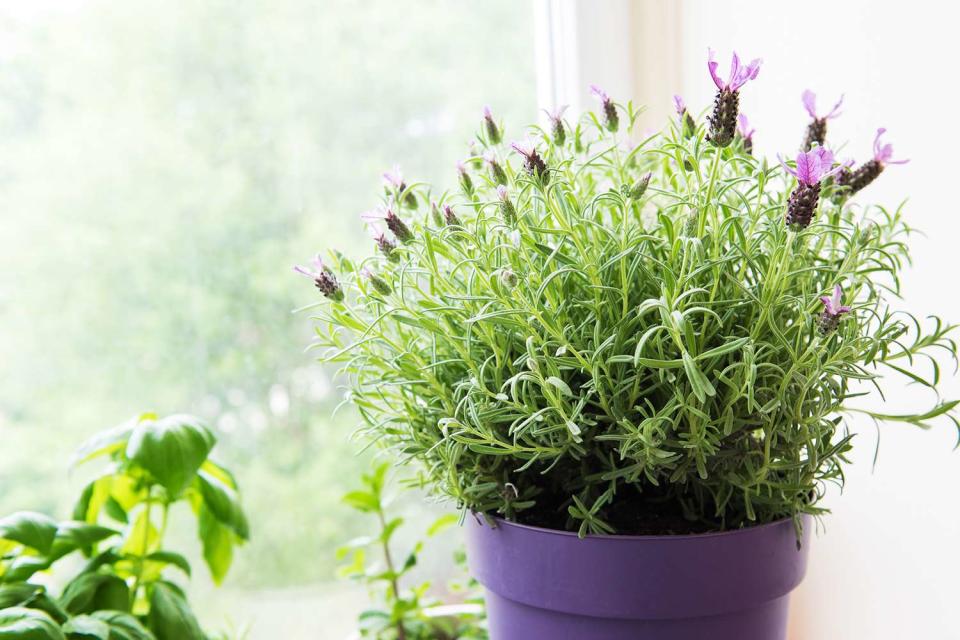How to Grow and Care for a Lavender Plant Indoors
Growing lavender indoors gives you year-round access to beautiful blooms, fresh fragrance, and flavoring for recipes.

Olena Rudo / Getty Images
Whether you’re looking to make an aromatic oil, flavor teas, decorate a room, or fill your home with a pleasant fragrance, lavender is the herb that you’ll want to grow because it has multiple uses in the home. Gardeners have so much love for this herbaceous perennial that they’ve even found a way to extend its growing season. Yes, it’s true: Even if you live in an area with freezing winter temperatures, it’s possible to grow lavender all year long. This is accomplished by growing the herbs outdoors in containers and then overwintering the plant indoors when the weather turns colder.
If you don’t have an existing garden, you can start your indoor herb garden with lavender transplants from your local garden center. Whichever planting route you choose, follow these nine tips to successfully grow and take care of lavender plants indoors to have a never-ending supply of this fragrant herb.
:
1. Select Dwarf Varieties to Grow Indoors
There are more than 450 varieties of lavender, so make sure you research and select the best lavender to grow indoors based on how you’re going to use it. If you want a dwarf variety that will perfume your rooms all season long, consider growing ‘Hidcote’ English lavender (Lavandula angustifolia)—its deep purple flowers can easily be kept dense for container growing. If you want to add sweet, light lavender leaves to your baked goods or other culinary creations, consider growing ‘Munstead' English lavender. If you want to add lavender stems to a tabletop vase, try growing ‘Kew Red’ or Spanish lavender with its showstopping flowers. French lavender (Lavandula dentata) is also pretty to look at with its serrated leaves, but its not as pleasant for eating.
2. Buy Transplants from Your Local Garden Center
Lavender seeds are difficult to germinate, so the easiest way to start growing lavender indoors is to buy young potted plants or transplants instead of trying to grow lavender from seed. Once you get your new lavender plant home, repot it into a container that’s one or two sizes larger than the original container. Growing lavender in terra-cotta pots works especially well because the herb prefers slightly drier conditions and water evaporates more quickly from the pot’s porous material.
3. Propagate Cuttings
You also can bring herbs indoors that have been growing outside all summer and repot them to extend the growing season indoors. Be sure to relocate your lavender indoors before the temperature drops below 40℉ to protect it from cold damage.
It’s not necessary to move an entire lavender plant indoors—just take a few cuttings from the plant. Simply cut a 3-inch section (measured from the tip of the stem) and strip off all the leaves on the bottom inch of stem. Then stick the stem into an evenly moist, sandy potting mix.
:
4. Provide Plenty of Light
Place your lavender plant in a warm location in summer and in a slightly cooler but bright location in winter. A kitchen windowsill with a southern exposure is usually a good spot for growing lavender indoors; it's in convenient reach while cooking and it's likely to have enough light and air circulation. Rotate the plant on a weekly basis so that all sides of the plant receive six to eight hours of direct sunlight. If there's not enough sunlight inside your home, place your lavender plant under grow lights for 12 to 14 hours each day.
5. Water Lavender When Soil Feels Dry
Water lavender when the top of the soil feels dry. Make sure the plant is not sitting in moist soil because overwatering can cause rotting and insect issues. Let the soil dry out slightly in between waterings.
6. Regulate Temperature Inside Your Home
For the best indoor growing conditions, keep your indoor temperatures between 60℉ degrees to 70℉ during the day and at least 10 degrees cooler at night. Keep your lavender plant away from the flow of forced-air heat and cold drafts.
7. Maintain Low Humidity Levels
Lavender prefers a low-humidity climate. Most homes have relative humidity levels of about 40 percent—that’s perfect for growing lavender. There’s no need to add extra humidity to their space with rock trays or to grow them in the bathroom for higher moisture levels.
8. Prune Carefully
Use a clean, sharp pair of garden scissors or pruners to snip the tops lightly. This will shape and stimulate your lavender plant to produce fresh new growth. The best time to prune lavender is in the spring. Once your plant is three or four years old and looks like it’s dying out in the center, cut stems back to about half their original length to encourage your plant to produce more new growth.
9. Harvest Flowers to Flavor Food and Decorate Your Home
Growing a lavender plant indoors gives you the benefit of having year-round access to this herb. To take advantage of when lavender’s essential oils are at their peak, pick the flower spikes when they have just opened—if you wait till the blooms are fully open, their fragrance will fade quickly. Leave the spikes intact and cut entire flower stems to dry if you’re making lavender bundles, wreaths, sachets, potpourri, or other decorations. You can also strip the individual flowers off the stems when they are fully dry and add the flower buds to lemonade,
butter, cakes, cookies, and meat rubs.

